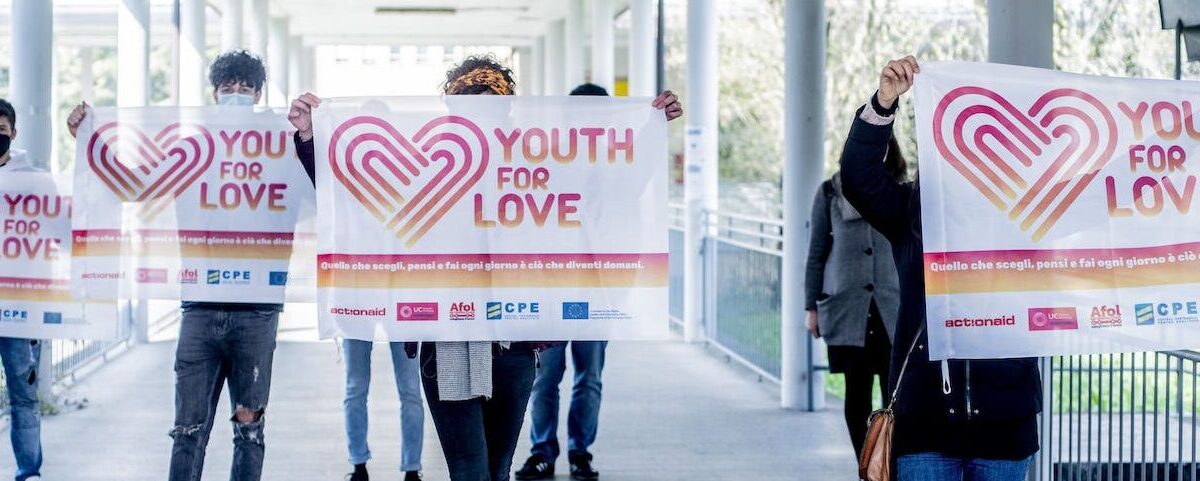For 4 in 5 young people, a woman can evade sexual intercourse if she really does not want to. Still 1 in 5 believes that girls can contribute to provoking sexual violence if they display excessively provocative clothing or behavior. Italian teens agree on who commits acts of violence in our country: boys, especially if in groups, and adult men whom it is possible to cross paths with even outside of school. Nearly 1 in 3 claims that many people who identify as nonbinary/fluid/trans are just following a trend of the moment. This is the finding of the “Youth and Peer Violence” survey conducted by Ipsos for ActionAid among a representative sample of about 800 girls and boys aged 14 to 19. The research took a snapshot of adolescents’ views on what they think violence is, how they react to and defend themselves against it, and how much gender stereotypes and prejudice affect their experiences. There is no general agreement on which behaviors are violent and which are not, indicating that there is a strong perception gap with respect to where violence lurks and its consequences.
“The data confirm what ActionAid has been observing in schools for years and that is the need to deal with violence beyond the forms of bullying and cyberbullying, which mainly affect the under-14s. Violence among teenagers has its roots in the patriarchal society that still influences the growth process of the new generations and does not allow the rape culture to be subverted from the ground up” says Maria Sole Piccioli ActionAid’s Education Manager.
“Minister Valditara’s proposal to introduce sex education in high schools it is not enough: we need mandatory co-designed training for teachers and students in all school cycles with autonomous and lay expert staff, the presence in school of tutors for prevention and case management; anti-harassment codes, neutral bathrooms and Alias Careers must be introduced. We ask that the Ministry of Education and Merit turns these proposals into concrete policies: we want the integration of the 2017 National Plan for Respect Education and stable funds for spaces and psychological support, which must be present in every school”, continues Maria Sole Piccioli, ActionAid’s Education Manager.
At the core of ActionAid’s demands there is an education to affectivity and sexuality that focuses not only on biological aspects, but also on psychological, social and emotional ones, as recommended by UNESCO and WHO.
Ipsos data: but why do people become objects of violence? In first place in the Ipsos research carried out with the support of IBISG -Italian Buddhist Institute Soka Gakkai are indicated physical characteristics (50%), then sexual orientation (40%) and gender affiliation (36%). The first harm indicated by 27% of respondents, regardless of gender, is psychological distress, in second place isolation and depression (21%) and in third place discomfort and shame (18%). Boys and girls who experience some form of violence do not always then report it. The main reason is shame in telling the adults, followed by fear of telling and the futility of reporting, fear of further threats from the aggressor. The 17-19 age group has the highest frequency of violent acts experienced, which may result from a greater awareness of what is experienced.
What is violence? For 80% of young people, four out of five, to touch someone’s private parts without their consent is a form of violence, while one in five do not recognize this violence. In second place, it is considered violence to hit someone, a behavior that registers 79% agreement, by far the most cited by males. In third place, with 78% of agreement, taking photos/videos in intimate situations and spreading them to other people, especially for girls with 84% of mentions.
Who suffers it? It is girls, more than boys, who most frequently experience acts of peer violence, in whatever form it manifests itself: much more often than peers they witness gossip, teasing, insults, jokes, exclusion of people from groups, situations in which a person’s intimate parts are touched without their consent, non-consensual dissemination of photos and videos of intimate situations. In addition, girls are more often at risk of receiving verbal harassment while walking down the street, being touched in their private parts, being the victim of sexual jokes or comments, and the dissemination of photos/videos depicting them in intimate situations. Boys, on the other hand, are mainly at risk of being beaten and transgender/fluid/non-binary people of being insulted.
THE PROJECT IN SCHOOLS WITH STUDENTS. “Youth for Love” is a program that has been active for more than four years at the Italian and European level, implemented in Italy by ActionAid. Among the Italian schools featured in the latest edition there are the Roberto Rossellini Film-TV Institute in Rome, the Paullo Vocational Training Center and the Oriani Mazzini Institute in Milan. Youth For Love is active in 10 other schools between Milan, Rome, Agrigento, Palermo, Syracuse and Reggio Calabria in the current edition realized through 8×1000 funds from the Italian Buddhist Institute Soka Gakkai.
The goal is to prevent, detect and address peer and gender-based violence in high schools (ages 14-18). The integrated training, empowerment and peer-to-peer program included 2,800 students, 600 teachers and school staff, 60 parents/guardians from primary and secondary education. Another 150 young people, 320 local actors and institutions were engaged in co-design projects of community practice to prevent and manage violence and national advocacy activities. Around three million people engaged through online campaigns and an interactive webgame dedicated to adolescents.
